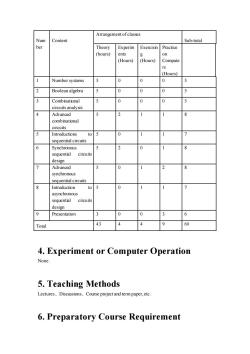同济大学:《逻辑网络》课程教学资源(教学大纲)逻辑网络(英文)Logic networks

Syllabus for Logic networks :School of electronics and information engineering No.of Course: Course Teacher:Junhe Zhou Language:English Students:Undergraduate students Total Hours:60 Credits:4 Number of students:40 Sem st Instructor:Junhe Zhou Exa niner:Xuefeng Yin 1.Course Description combinational circuits and sequential circuits,students are expected to gain the ability to understand basic logic diagrams and analyze their logic functions,to design a circuits fulfilling certain functions Through the course project and term paper,students are expected to use their knowledge in practical applications. 2.Course Objectives and Requirements 1.Course Objectives: The aim of this course is to introduce the fundamental conceptsof logic networks to the students,toenable them to design and analyzea digital system 2.Requirements:The attendees should understand the basic concept of the digital circuits. including the combinational and sequential circuits,be able to analyze and design the circuits with proper mathematical methods and development tools. 3.Course Arrangement 1. Number systems:binary systems,decimal systems,hex decimal systems Transition between two different number systems. 2. Boolean algebra:basic postulates for algebra system,duality property.theorems.concept of Boolean functions,basic logic gates. 3.Combinational circuits analysis,K-map,Combinational circuits design. Advanced combinational circuits:Adder,subtracter,mux,demuxencoder,decoder ALUstructures. 5.Introductionsto sequential circuits:JK,DandTflip flop,RSD latches,state table,state equation,state diagram,finite state machine. 6. Synchronous sequential circuits design:stateoptimization(state reduction method,state assignment method).design using different flip fops(JK.DandTflip flops) Advanced synchronoussequential circuits:registers and counters Introduction to asynchronous sequential circuits design
Syllabus for Logic networks School/college: School of electronics and information engineering No. of Course: Course Teacher:Junhe Zhou Language:English Students: Undergraduate students Total Hours:60 Credits: 4 Number of students :≤ 40 Semester:First Instructor:Junhe Zhou Examiner:Xuefeng Yin 1. Course Description The course is an introduction to the design and analysis principles of the digital circuits. Based the instruction of the basic logic concept of number theory, Boolean algebra, combinational circuits and sequential circuits, students are expected to gain the ability to understand basic logic diagrams and analyze their logic functions, to design a circuits fulfilling certain functions. Through the course project and term paper, students are expected to use their knowledge in practical applications. 2. Course Objectives and Requirements 1. Course Objectives: The aim of this course is to introduce the fundamental concepts of logic networks to the students, to enable them to design and analyze a digital system. 2. Requirements: The attendees should understand the basic concept of the digital circuits, including the combinational and sequential circuits, be able to analyze and design the circuits with proper mathematical methods and development tools. 3. Course Arrangement 1. Number systems: binary systems, decimal systems, hex decimal systems. Transition between two different number systems. 2. Boolean algebra: basic postulates for algebra system, duality property, theorems, concept of Boolean functions, basic logic gates. 3. Combinational circuits analysis, K-map, Combinational circuits design. 4. Advanced combinational circuits: Adder, subtracter, mux, demux, encoder, decoder, ALU structures. 5. Introductions to sequential circuits: JK, D and T flip flop, RS D latches, state table, state equation, state diagram, finite state machine. 6. Synchronous sequential circuits design: state optimization (state reduction method, state assignment method), design using different flip flops (JK, D and T flip flops) 7. Advanced synchronous sequential circuits: registers and counters. 8. Introduction to asynchronous sequential circuits design

Arrangement ofclasses Content Sub-total Theory Experim Exercisin Practice (hours) ents on (Hours) (Hours) Compute Hours) Number systems Boolean algebra 3 Combinational 5 circuits analysis advanced 5 combinational circuits Introductions to 5 7 sequential circuits 6 Synchronous 5 equential design Advanced synchronous sequential circuits n troduction asynchronous sequential circuits design 9 Presentation 3 0 0 6 Total 43 60 4.Experiment or Computer Operation None. 5.Teaching Methods Lectures,Discussions,Course project and term paper,etc. 6.Preparatory Course Requirement
Num ber Content Arrangement of classes Sub-total Theory (hours) Experim ents (Hours) Exercisin g (Hours) Practice on Compute rs (Hours) 1 Number systems 5 0 0 0 5 2 Boolean algebra 5 0 0 0 5 3 Combinational circuits analysis 5 0 0 0 5 4 Advanced combinational circuits 5 2 1 1 8 5 Introductions to sequential circuits 5 0 1 1 7 6 Synchronous sequential circuits design 5 2 0 1 8 7 Advanced synchronous sequential circuits 5 0 1 2 8 8 Introduction to asynchronous sequential circuits design 5 0 1 1 7 9 Presentation 3 0 0 3 6 Total 43 4 4 9 60 4. Experiment or Computer Operation None. 5. Teaching Methods Lectures、Discussions、Course project and term paper, etc. 6. Preparatory Course Requirement

Circuits theory,analogcircuit 7.Learning Outcomes Expected Category Leaming Outoomes Understand to operation principlesofnumber systems, understand howto convert between two different number systems. 2 Understand the basic postulates for Boolean algebra,able to Master of Knowledge 4.Understand operation principles for logic moduleslike circuits:Adder,subtracter,mux,demux,encoder,decoder, and AlU structures 5 Able to analyze and design simple sequential circuits. .Toe the basicknowledge and capabilityfor course,such as very large scale integrated circuits learned 2,To learn the methods to analyze and design logic networks. 1.Able to apply the knowledge to design logic circuits for Practical skills learned practical applications. .The capability of applying knowedge learned into oractical applications. Personal competences 2,The capability ofpresenting project and organizing materials and characters 3,Team work Cultivated 4.The capability ofsearching academic papers in thedigital data a50 5.The capability of writing a academic paper. 8.Performance Evaluation:Means Ratio Evaluation Means Ratio(%) Link with learning outcomes expected Term paper and course The capability to implement the knowledge. project 20 Attendance and 10 The attitude to learn the knowledge Eng婴ement Exam 70 The capability to understand the knowledge. 9.Textbooks and Main Reference Books
Circuits theory, analog circuit 7. Learning Outcomes Expected Category Learning Outcomes Master of Knowledge 1. Understand to operation principles of number systems, understand how to convert between two different number systems. 2. Understand the basic postulates for Boolean algebra, able to prove basic theorems. 3. Able to analyze and design simple combinational circuits. 4. Understand operation principles for logic modules like circuits: Adder, subtracter, mux, demux, encoder, decoder, and ALU structures. 5. Able to analyze and design simple sequential circuits. Intellectual abilities learned 1. To learn the basic knowledge and capability for next level course, such as very large scale integrated circuits. 2, To learn the methods to analyze and design logic networks. Practical skills learned 1. Able to apply the knowledge to design logic circuits for practical applications. Personal competences and characters Cultivated 1. The capability of applying knowledge learned in class into practical applications. 2, The capability of presenting project and organizing materials 3, Team work 4, The capability of searching academic papers in the digital data base. 5, The capability of writing a academic paper. 8. Performance Evaluation: Means & Ratio Evaluation Means Ratio(%) Link with learning outcomes expected Term paper and course project 20 The capability to implement the knowledge. Attendance and Engagement 10 The attitude to learn the knowledge. Exam 70 The capability to understand the knowledge. 9.Textbooks and Main Reference Books 1) Textbook Moris Mano, Logic networks, Prentice Hall, third ed. 2002

10.Assignment Requirements 1,Finish the homework after each lecture. 2,Finish the term paper based on the requirement from the instructor. 3.Finish the course project based ona practical application. 4,Present the results of project in the class afterask/answer the question regarding the project. Appendices: None
10. Assignment Requirements 1,Finish the homework after each lecture. 2,Finish the term paper based on the requirement from the instructor. 3,Finish the course project based on a practical application. 4,Present the results of project in the class after ask/answer the question regarding the project. Appendices: None
按次数下载不扣除下载券;
注册用户24小时内重复下载只扣除一次;
顺序:VIP每日次数-->可用次数-->下载券;
- 同济大学:《逻辑网络》课程教学资源(教学大纲)逻辑网络(中文,负责人:周俊鹤).doc
- 北京化工大学:《数据结构》课程PPT教学课件(C语言描述)第六章 查找.ppt
- 北京化工大学:《数据结构》课程PPT教学课件(C语言描述)第五章 图.ppt
- 北京化工大学:《数据结构》课程PPT教学课件(C语言描述)第三章 栈和队列.ppt
- 北京化工大学:《数据结构》课程PPT教学课件(C语言描述)第二章 线性表.ppt
- 北京化工大学:《数据结构》课程PPT教学课件(C语言描述)第一章 绪论(负责人:侯虹).ppt
- 北京化工大学:《大学计算机基础》课程电子教案(PPT教学课件)第7章 多媒体技术基础.ppt
- 北京化工大学:《大学计算机基础》课程电子教案(PPT教学课件)第6章 数据库基础.ppt
- 北京化工大学:《大学计算机基础》课程电子教案(PPT教学课件)第5章 程序设计与软件工程基础.ppt
- 北京化工大学:《大学计算机基础》课程电子教案(PPT教学课件)第4章 计算机网络技术基础.ppt
- 北京化工大学:《大学计算机基础》课程电子教案(PPT教学课件)第3章 操作系统.ppt
- 北京化工大学:《大学计算机基础》课程电子教案(PPT教学课件)第2章 计算机系统结构与硬件基础.ppt
- 北京化工大学:《大学计算机基础》课程电子教案(PPT教学课件)第1章 计算机与信息技术概述.ppt
- 北京化工大学:《大学计算机基础》课程教案资源(教案讲义)教学大纲 The Foundation of University Computer(负责人:朱群雄).doc
- 中国人民大学:《程序设计实践》课程教学资源(讲稿)第11讲 Untangle Puzzle Game.pdf
- 中国人民大学:《程序设计实践》课程教学资源(讲稿)Fundamentals of Git.pdf
- 中国人民大学:《程序设计实践》课程教学资源(讲稿)第9讲 jQuery简介.pdf
- 中国人民大学:《程序设计实践》课程教学资源(讲稿)第7讲 Canvas游戏.pdf
- 中国人民大学:《程序设计实践》课程教学资源(讲稿)第6讲 Javascript HTML DOM.pdf
- 中国人民大学:《程序设计实践》课程教学资源(讲稿)第5讲 Javascript入门.pdf
- 同济大学:《逻辑网络》课程教学资源(试卷习题)考试样卷.doc
- 同济大学:《逻辑网络》课程电子教案(PPT课件)同步时序电路设计中的问题 Advanced design issue.ppt
- 同济大学:《逻辑网络》课程电子教案(PPT课件)寄存器与计数器 register and counters.ppt
- 同济大学:《逻辑网络》课程电子教案(PPT课件)异步时序电路分析与设计 Introduction to asynchronous circuits design.ppt
- 同济大学:《逻辑网络》课程电子教案(PPT课件)数字设计中的基本电路 Introduction to the circuits in digital design.ppt
- 长沙理工大学:《微机原理与接口技术》课程教学资源(大纲教案)微机原理与应用授课教案(负责人:叶青,打印版).pdf
- 《算法基础》课程教学资源(学习笔记)算法基础 课堂笔记.pdf
- 西安电子科技大学:《网络计算》课程PPT教学课件(Android Programming)Lecture 1 Introduction to Network Computing(主讲:栾浩).pptx
- 西安电子科技大学:《网络计算》课程PPT教学课件(Android Programming)Lecture 2 Introduction to Java and Object Oriented Programming.pptx
- 西安电子科技大学:《网络计算》课程PPT教学课件(Android Programming)Lecture 3 File structure and Layout.pptx
- 西安电子科技大学:《网络计算》课程PPT教学课件(Android Programming)Lecture 4 Activity, Intent and UI.pptx
- 西安电子科技大学:《网络计算》课程PPT教学课件(Android Programming)Lecture 5 Intent.pptx
- 西安电子科技大学:《网络计算》课程PPT教学课件(Android Programming)Lecture 6 List View and Custom View.pptx
- 西安电子科技大学:《网络计算》课程PPT教学课件(Android Programming)Lecture 7 Data Persistence.pptx
- 西安电子科技大学:《网络计算》课程PPT教学课件(Android Programming)Lecture 8 Multi-threading.pptx
- 西安电子科技大学:《网络计算》课程PPT教学课件(Android Programming)Lecture 9 Service and Broadcast Receiver.pptx
- 西安电子科技大学:《网络计算》课程PPT教学课件(Android Programming)Lecture 10 Multimedia.pptx
- 同济大学:《软件测试》课程电子教案(PPT课件)Chapter 01 Soft Testing - Fundamentals of Testing.pptx
- 同济大学:《软件测试》课程电子教案(PPT课件)Chapter 02 Testing throughout the Software Lifecycle.pptx
- 同济大学:《软件测试》课程电子教案(PPT课件)Chapter 03 Static Techniques.pptx
